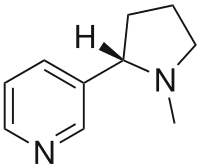
Photo from wikipedia
The detrimental health effects associated with tobacco use constitute a major public health concern. The addiction associated with nicotine found in tobacco products has led to difficulty in quitting among… Click to show full abstract
The detrimental health effects associated with tobacco use constitute a major public health concern. The addiction associated with nicotine found in tobacco products has led to difficulty in quitting among users. Nicotinic acetylcholine receptors (nAChRs) are the targets of nicotine and are responsible for addiction to tobacco products. However, it is unknown if the other >8000 tobacco constituents are addictive. Since it is time-consuming and costly to experimentally assess addictive potential of such larger number of chemicals, computationally predicting human nAChRs binding is important for in silico evaluation of addiction potential of tobacco constituents and needs structures of human nAChRs. Therefore, we constructed three-dimensional structures of the ligand binding domain of human nAChR α7 subtype and then developed a predictive model based on the constructed structures to predict human nAChR α7 binding activity of tobacco constituents. The predictive model correctly predicted 11 out of 12 test compounds to be binders of nAChR α7. The model is a useful tool for high-throughput screening of potential addictive tobacco constituents. These results could inform regulatory science research by providing a new validated predictive tool using cutting-edge computational methodology to high-throughput screen tobacco additives and constituents for their binding interaction with the human α7 nicotinic receptor. The tool represents a prediction model capable of screening thousands of chemicals found in tobacco products for addiction potential, which improves the understanding of the potential effects of additives.
Journal Title: Oncotarget
Year Published: 2018
Link to full text (if available)
Share on Social Media: Sign Up to like & get
recommendations!